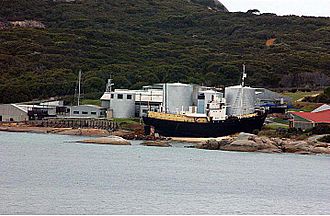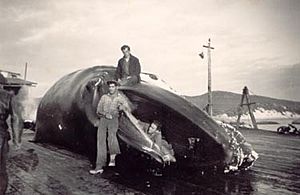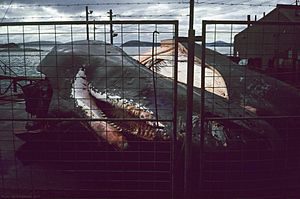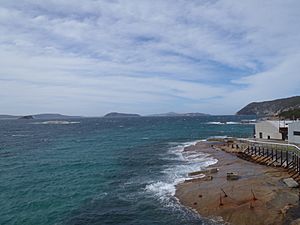Cheyne Beach Whaling Station facts for kids
Quick facts for kids Cheyne Beach Whaling Station |
|
|---|---|

The station in 2013
|
|
| General information | |
| Type | Historic Whaling Station |
| Location | Albany, Western Australia |
| Coordinates | 35°05′41″S 117°57′35″E / 35.09472°S 117.95972°E |
| Type | State Registered Place |
| Designated | 15 May 1998 |
| Reference no. | 3644 |
The Cheyne Beach Whaling Station is an old whaling station in Australia that no longer operates. Today, it is a popular place for tourists called Albany's Historic Whaling Station.
This station is located in Frenchman Bay, which is part of King George Sound. It was built in the 1950s and stopped its whaling work in 1978. The station got its name from Cheynes Beach, a small town about 65 kilometres (40 miles) east of Albany, Western Australia. This area is surrounded by Waychinicup National Park.
Contents
History of Whaling at Cheyne Beach
People have been whaling near Cheynes Beach since the 1840s. A commercial fishing business started there in 1920. Whaling began again in the early 1950s.
Starting the Whaling Company
The Cheynes Beach Whaling Company was formed by a group of eight fishermen from the same family. Two men from Albany, G. R. Birss and C. Westerberg, led this group. They planned to spend about £20,000 to start their business. Soon after, the company moved its operations to the Frenchman Bay site.
Building the Station
In 1951, rules were made about how many humpback whales could be caught. The whaling station was built at Frenchman Bay in 1952. This big factory was designed to process whales caught nearby. It had large steel and concrete sheds, workshops, and smaller wooden offices. There were also tanks and boilers.
Much of the station was built using old mining equipment. It even used parts from an alcohol making plant from Collie. The area where whales were cut up, called the flensing deck, was built over a natural rock slope. Powerful steam machines were put further up the shore to pull the huge whale bodies onto this deck. In the first year, they were allowed to catch 50 humpback whales.
Whale Oil Production
In 1953, the station produced about 500 tonnes (492 long tons) of whale oil. This oil was loaded onto a Norwegian boat called Toulouse. A smaller boat, the Cheynes (a whale chaser), carried the oil from the station to the larger ship.
By 1954, the station loaded over 1,000 tonnes (984 long tons) of whale oil. This was from 120 whales, which was their entire catch for the season. The oil was loaded directly onto another Norwegian ship, the Tiber, again using the Cheynes chaser. This oil was worth an estimated £100,000.
Growth and Change
The company slowly grew bigger. In 1957, they bought a second whale chaser boat called Kos VII.
In 1962, they had a very bad year with very few whales caught. Because of this, the International Whaling Commission stopped the hunting of humpback whales from Antarctic waters. So, the company started hunting sperm whales instead.
The business continued to make money. In 1969, the company made a profit of AUD$100,362. This grew to AUD$304,329 in 1970. These higher profits were because they caught a record number of sperm whales that year (764 in total). Also, there was a huge demand for whale oil around the world. The company had over 100 employees. The whale oil was even used by NASA and to make Swiss watches!
Whaling continued at the station until 1978. This was when the last whale was legally caught in Australian waters.
Station Closure and Museum
Between 1952 and 1978, the station caught a total of 1,136 humpback whales and 14,695 sperm whales.
The Cheynes Beach Whaling Company closed down in 1978. In 1980, the site was given to the Jaycees Community Foundation, a community group. This group used money from the government and private donations to turn the station into a museum. It was first called Whaleworld and officially opened in May 1985. Today, the museum is known as Albany's Historic Whaling Station.





